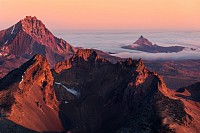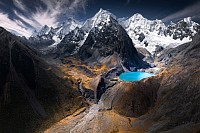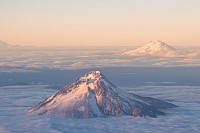Facts On Mountain Photography
Unlocking the full potential of your camera involves understanding and mastering essential settings, particularly when capturing the stunning beauty of nature. Mountain photography is a field where these skills are put to the test. As a mountain photographer, you must be adept at adjusting your camera's settings to account for varying light conditions and dramatic landscapes. This not only enhances the quality of your images but also brings out the awe-inspiring details of towering peaks and expansive vistas. Learning to manipulate settings like ISO, aperture, and shutter speed can make a significant difference in your mountain landscape photography. One crucial aspect of mountain landscape photography is choosing the right aperture. A smaller aperture (higher f-stop number) increases the depth of field, ensuring that both the foreground and background are in sharp focus. This is particularly useful for capturing intricate details in landscape photos. On the other hand, a larger aperture (lower f-stop number) can be used creatively to blur the background, highlighting a specific element in the scene. Understanding when and how to adjust the aperture allows you to create more dynamic and visually appealing images.
Shutter speed is another vital setting for any mountain photographer. A fast shutter speed can freeze motion, which is perfect for capturing fast-moving elements like flowing water or shifting clouds. Conversely, a slower shutter speed can introduce a sense of motion and drama to your landscape photos, such as the silky effect of a waterfall. Mastering shutter speed settings enables you to adapt to various shooting conditions and achieve the desired artistic effect in your photographs. This skill is particularly beneficial when creating large landscape photography prints that capture the essence of the natural world. ISO settings also play a significant role in mountain landscape photography. Lower ISO values are ideal for bright conditions and ensure high image quality with minimal noise. In contrast, higher ISO settings are useful in low-light situations but can introduce graininess to the photos. A proficient mountain photographer knows how to balance ISO settings to maintain clarity and detail, especially when preparing images for large landscape photo prints. By mastering ISO, you can take full advantage of natural lighting and enhance the overall quality of your landscape shots.
Finally, combining these settings effectively can result in breathtaking landscape photography prints. The interplay between aperture, shutter speed, and ISO determines the exposure and quality of your photographs. When printing your work, especially in large landscape photo prints, these details become even more critical. High-quality prints showcase every nuance and texture, bringing the natural beauty of the scene to life. Whether displayed in a gallery or your home, these prints allow viewers to experience the grandeur of nature up close. In conclusion, mastering your camera’s settings is essential for excelling in mountain photography and producing stunning landscape photos. By understanding and controlling aperture, shutter speed, and ISO, you can create high-quality images suitable for large landscape photography prints. These skills not only enhance your capabilities as a mountain photographer but also ensure that your photographs, when turned into landscape photography prints, captivate and inspire viewers. Investing time in learning these settings will elevate your photography, allowing you to capture and share the beauty of the natural world through exquisite large landscape photo prints.
A Little Bit About Mountain Photographer
Photography is more than just capturing a moment; it's about telling a story through your lens. Mountain photography is an excellent example of this, where every shot can convey the grandeur, challenge, and beauty of nature. As a mountain photographer, you need to consider various elements like composition, lighting, and timing to create impactful images. Each photograph should tell a story, inviting viewers to explore the scene and experience the emotions it evokes. Whether you’re capturing a serene sunrise or a stormy peak, your goal is to make the viewer feel as though they are part of the scene. In mountain landscape photography, composition is key. Using the rule of thirds can help you create balanced and engaging images. Placing your subject, such as a mountain peak, off-center draws the viewer’s eye into the landscape. Leading lines, like rivers or trails, can guide the viewer through the photograph, adding depth and interest.
These techniques are especially effective when creating large landscape photography prints, as they ensure the image remains compelling even when enlarged. Thoughtful composition transforms a simple snapshot into a powerful visual narrative. Lighting plays a crucial role in mountain photography. The golden hours of sunrise and sunset provide soft, warm light that enhances the natural beauty of the landscape. As a mountain photographer, you should aim to capture these moments when the light is most flattering. Shadows and highlights add texture and dimension to your photos, making them more dynamic and realistic. Proper lighting is essential for producing high-quality landscape photography prints that truly stand out. The interplay of light and shadow can turn an ordinary scene into a breathtaking masterpiece. Patience and timing are vital in mountain landscape photography. Nature is unpredictable, and the perfect shot often requires waiting for the right conditions.
As a dedicated mountain photographer, you might spend hours or even days waiting for the ideal moment. This patience pays off when you capture a unique, fleeting scene that few others have seen. These moments make for stunning large landscape photo prints that capture the essence of the natural world. The effort you put into timing and patience is evident in the final image, making it more impactful and memorable. Moreover, displaying your work as large landscape photography prints allows others to appreciate the detail and scale of your images. High-quality prints can transform any space, bringing the beauty of the outdoors inside. When choosing to print your photos, consider using premium materials to ensure longevity and vibrancy. Landscape photography prints not only serve as decoration but also as a testament to your skill and vision as a photographer. They allow viewers to experience the landscapes you've captured, feeling the same awe and wonder that you felt when you took the shot.
Precise Study On The Mountain Landscape Photography
hotography is an art that goes beyond merely the act of pointing a camera at it and clicking. Mastering the art of composition is essential for creating stunning photographs that captivate the viewer's eye. The most difficult yet rewarding forms of photography is mountain photography. Capturing the grandeur and majesty of mountains requires an knowledge of light perspective, light and timing. Mountain photographers must be patient, often waiting for hours to capture the perfect shot. The result, however, is often breathtaking, showcasing nature in its most awe-inspiring form. When it comes to mountain landscape photography, the proper composition can be the key to success. One effective technique is to employ the rule of thirds. by placing the mountain or other focal points away from center to create a dynamic picture. Leading lines, like rivers or trails, can draw the viewer's attention to the photo, creating depth and dimension. Browse the below mentioned site, if you are seeking for more information concerning mountain landscape photography.
Photographers who shoot in areas like those of the Lake District, incorporating these elements can turn ordinary photographs of the lake district into extraordinary pieces of art. Prints of large landscapes are an extremely popular method to showcase these amazing images. The size of the print can give the viewer the impression like they're standing there in the landscape. The choice of the best frame and display technique is essential to highlight your appreciation of the photo. Prints of high-quality landscape photography can transform a space, bringing the serenity and magnificence of nature into your office or home. These prints aren't only decorations, but doors to the most breathtaking landscapes. Timing is an additional factor in mountain photography. The golden hours, just after sunrise and before sunset, are the ideal time to shoot for lighting. In these hours the light is warm and soft creating long shadows and highlighting the texture of the landscape. The mountain photographer should also be prepared for changing weather conditions, which can dramatically alter the scene. The right place at the right time could result in a truly magical photograph, capturing what the nature has to offer in its most beautiful light.
If you're looking to buy huge landscape photo prints there are some things to think about. Quality of print essential and it must be made with high-resolution photos and printed on top quality paper or canvas. Its subject is also important. Lake District landscape photos, for instance, are sought-after for their breathtaking beauty and tranquil scenes. If you're a photographer or a collector, investing in top-quality photographs of landscapes can bring a bit of nature's splendor into your life. In the end, learning to compose your photos is a skill which can take your photography from mundane to spectacular. If you're focusing in mountain-photography or serene lakes, the principles of good composition are the same. When you pay attention to the elements like the rule of thirds as well as leading lines and lighting, you are able to create images that not only capture a moment in time but also tell the story. High-quality large landscape photography prints provide a permanent reminder of these beautiful images, and allow you to share your images to the world.



